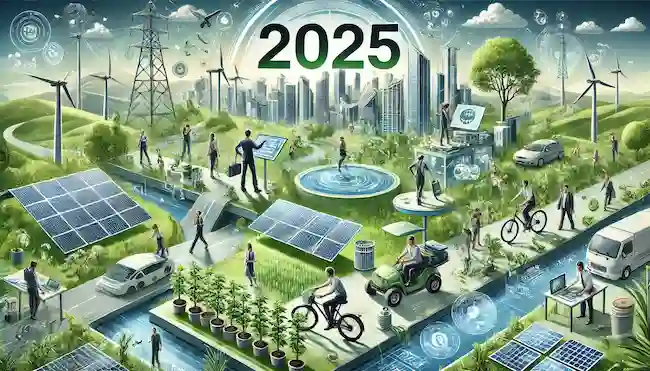Setting Realistic Environmental Goals for a Business
In today’s world, where environmental sustainability is a pressing concern, businesses increasingly recognise the need to integrate environmental goals into their strategies. However, ensuring the goals set are realistic is crucial if positive progress is to be achieved.
Here’s a comprehensive guide covering how to set realistic environmental goals that deliver a positive contribution, both to your business and the environment.
Understand the Importance of Environmental Goals

Setting environmental goals is vital to reducing a business’s ecological footprint, conserving resource use, and limiting contribution to climate change.
By setting and achieving the environmental goals, businesses can:
First, Assess Current Environmental Impact

Before setting goals, a business must understand its current environmental impact. This involves:
Set Out to Align Goals with the Business Strategy

Environmental goals should align with the overall business strategy. This ensures goals can be integrated into core operations and receive the necessary support and resources. Consider the following steps:
Goals Set Should be SMART
To be effective, environmental goals should be SMART: Specific, Measurable, Achievable, Relevant, and Time-bound.
Specific: Clearly define what you aim to achieve. For instance, instead of a vague goal like “reduce energy consumption,” specify “reduce energy consumption by 15% within the next two years.”
Measurable: Quantify the goals to track progress. Use metrics such as percentage reductions, absolute figures, or per-unit measures.
Achievable: Set realistic goals that are challenging yet attainable. Consider the current capabilities and resources of the business.
Relevant: Ensure the goals are pertinent to the business’s operations and overall strategy.
Time-bound: Set deadlines to create a sense of urgency and drive action.
Setting The Goals
Step 1: Identify Key Areas for Improvement
Focus on areas where the business can make the most significant environmental impact. Common areas include:
Energy Efficiency: Implement measures to reduce energy use, such as upgrading to energy-efficient equipment, optimising processes, and utilising renewable energy sources.
Waste Management: Reduce waste generation, increase recycling and composting, and adopt circular economy practices.
Water Conservation: Implement water-saving technologies and practices, and reduce water wastage.
Emissions Reduction: Reduce greenhouse gas emissions through process optimisation, adopting clean technologies, and using low-emission transportation.
Sustainable Sourcing: Ensure raw materials and products are sourced sustainably, and work with suppliers to improve their environmental performance.
Step 2: Developing the Action Plan

An action plan should clearly setting out the areas you have identified for improvement, the actions you will take to improve performance in these areas, and the steps needed to achieve the actions. The plan should include:
Step 3: Involve Stakeholders
Engage various stakeholders, including employees, customers, suppliers, and the local community, in the goal-setting process. Review the initial areas for improvement and actions identified, seek feedback, and use it to improve your approach.
This stakeholder engagement can help in:
Step 4: Implement and Monitor Progress

Implement the action plan with a focus on continuous improvement. This requires you to regularly monitor progress, using key performance indicators (KPIs), and adjusting the strategy as needed.
Consider the following in your approach:
Step 5: Communicate and Report Progress
Transparency is crucial for building trust and accountability. Regularly communicate your progress to stakeholders through:
Internal Communications: Keep employees informed and engaged. Newsletters, meetings, and training sessions are options to consider.
External Communications: Use social media, press releases, and other channels to share achievements with customers, investors, and the broader community.
Sustainability Reports: Depending on the size of your organisation, publishing annual or bi-annual sustainability reports detailing the progress toward environmental goals can be beneficial. Be aware though though that most will only read the headlines of a report, so avoid length document if you can.
Step 6: Review and Revise Goals
Environmental goals should be dynamic and adaptable.
Periodically review and revise them to reflect changes in the business environment, technological advancements, and evolving stakeholder expectations. Consider the following:
Environmental Goals: Valuable and Practical For Business

Setting realistic environmental goals is a critical step for businesses aiming to contribute positively to the environment and achieve long-term sustainability.
They not only helps in mitigating environmental impacts, but also enhances the business’s reputation, compliance, and overall success in a competitive market.
By incorporating the steps we have detailed, businesses can set realistic environmental goals that both drive meaningful change and achieve practical, sustainable growth.
If you are looking to advance the sustainability of your business further, we also recommend the following resources:
Net Zero Business: A Simple Guide to Getting Started
Sustainability For Small Business
Carbon Offsetting Made Simple: An Overview
Heat Decarbonisation: Practical Steps & Factors to Know
Plus, plenty more resources and insights below!
Any questions, then feel free to get in touch via [email protected], or through the comments section below.







